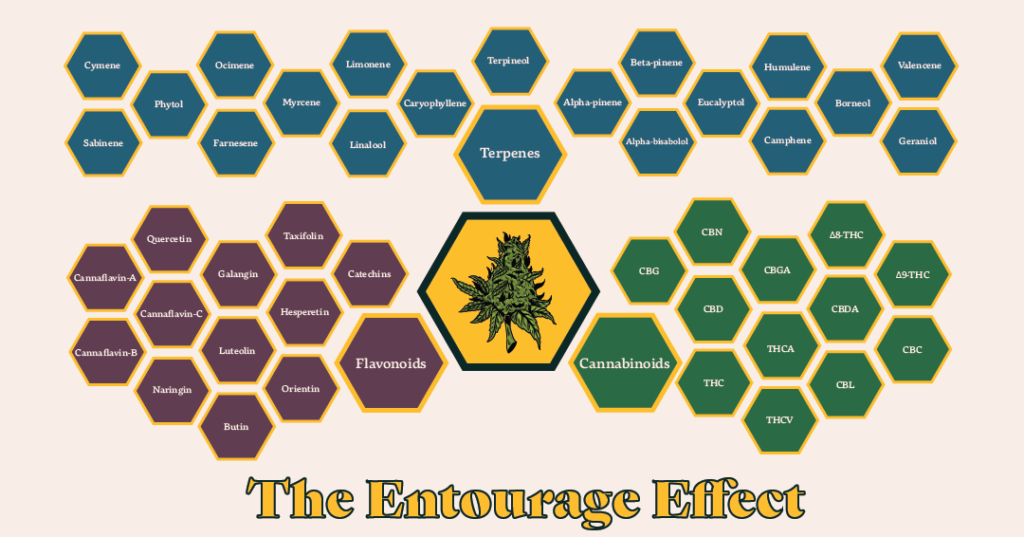
Cannabis is a very complex plant; at its surface we see a green (or purple) bud covered in sticky and lustrous resin called trichomes. However, though it may appear to be the case, trichomes are not a homogenous entity. Each glistening trichome head is packed full of unique terpenes, cannabinoids, and flavonoids which give each strain its unique smells, tastes, and effects.
While how the entourage effect works to produce specific experiences is complicated, understanding how it operates in principle is simple. When we consume cannabis, we are taking in dozens of botanical compounds each of which has its own unique properties. When these compounds are absorbed into the bloodstream in varying concentrations, they work in tandem to influence how a specific strain makes us feel.
Diving deeper into the entourage effect we look at the three major compounds found in cannabis, which are Cannabinoids, Terpenes and Flavonoids.
We begin with the more commonly known compounds: Cannabinoids. Most cannabis consumers know the two most common of these compounds, THC and CBD. As we know, THC is the cannabinoid that delivers psychoactive effects, creating that feeling of being “high”, while CBD is excellent in alleviating inflammation. But there are a very wide range of cannabinoids out there, all of which work harmoniously together to determine the effects we feel from consumption. CBN, CBC, and CBG are just a few of the lesser-known cannabinoids beginning to make their way into mainstream knowledge.
Next, we have terpenes. Terpenes naturally occur in all plants, and serve a vast array of functions for cannabis such as immune system support and defense from insects. They are responsible for aromas, flavours, and in some cases can even affect the colour of the plant. When you buy a bag of fresh cannabis and stuff your nose in it to get the sweet, fruity, earthy, and piney scents, they originate from the terpene content of that bud. While there is still a great deal to learn on this front, we do know the effects of some terpenes. For example, myrcene can be beneficial for those suffering from insomnia, while caryophyllene is useful for relieving pan and inflammation in tandem with THC.
Lastly, we have Flavonoids, a diverse group of plant chemicals found in most fruits, vegetables, and in some flowers. Some of which are found uniquely in the cannabis plant and are referred to as cannaflavins. In recent years scientists have turned to various flavonoids to explain some of the health benefits found in fruits and vegetables. Unfortunately, there is still much to be learned on how flavonoids influence the effects of different cannabis cultivars. For now, what we can say with certainty is that flavonoids impact the taste, smell, and even colour of your cannabis plants. If you’re a lover of purple cannabis flowers, you can give your thanks to anthoxanthins, the flavonoid which give fruits like berries their colour. There is also research to suggest flavonoids are highly pharmacologically active, featuring anti-fungal, antioxidant, and cardiovascular health benefits to name a few. While there is still much we don’t know, with cannabis no longer being taboo in the world of medical research our knowledge of these mysterious compounds is sure to expand in the coming years.
Though we still don’t have all of the information required to fully understand the entourage effect, we do know the effects of cannabis are brought on by the coalescence these complex compounds. This is why you may purchase a very high in THC product but be disappointed in the lackluster effects you experience. In short, when looking to purchase cannabis, take on a holistic view of the plant’s specific terpenes and cannabinoids, rather than getting tunnel vision for high THC percentages.


